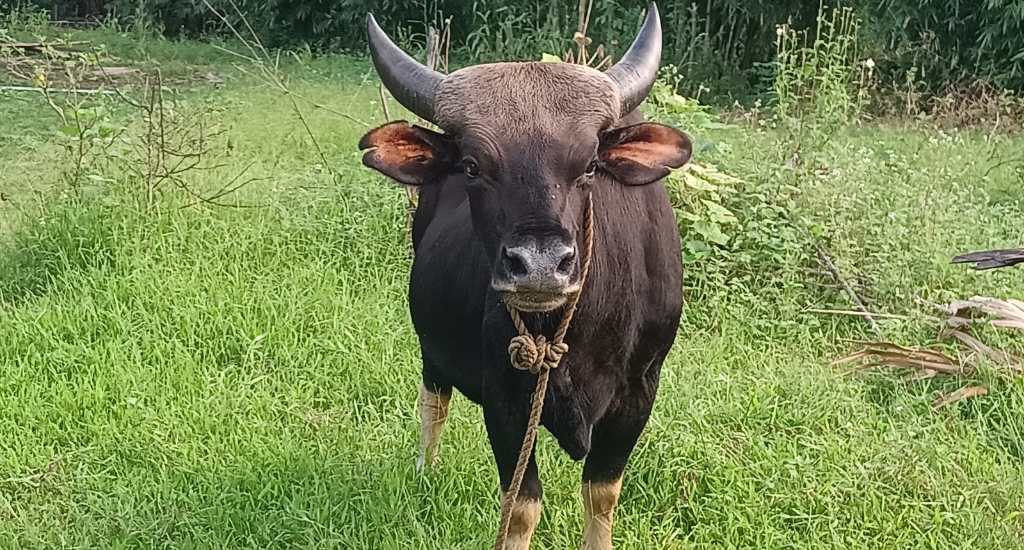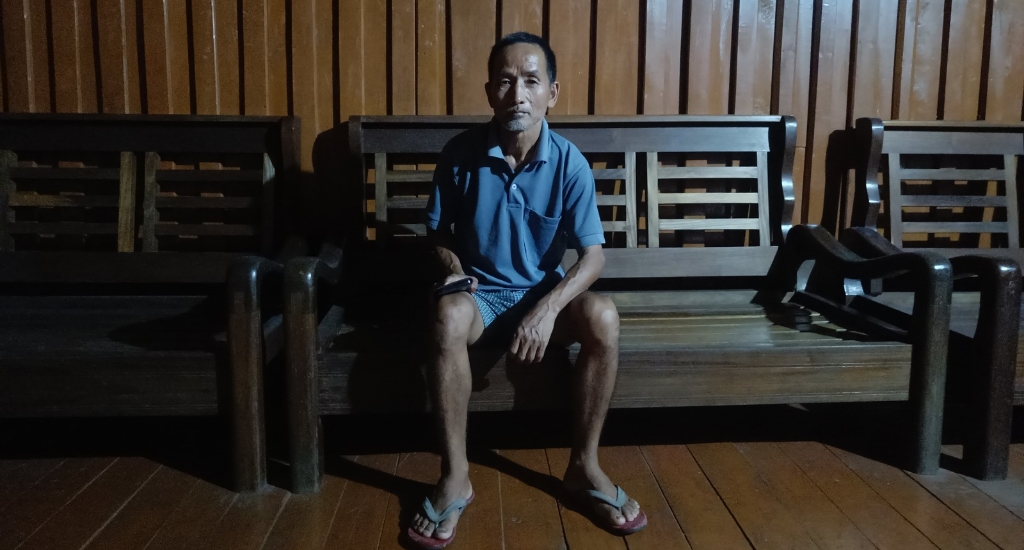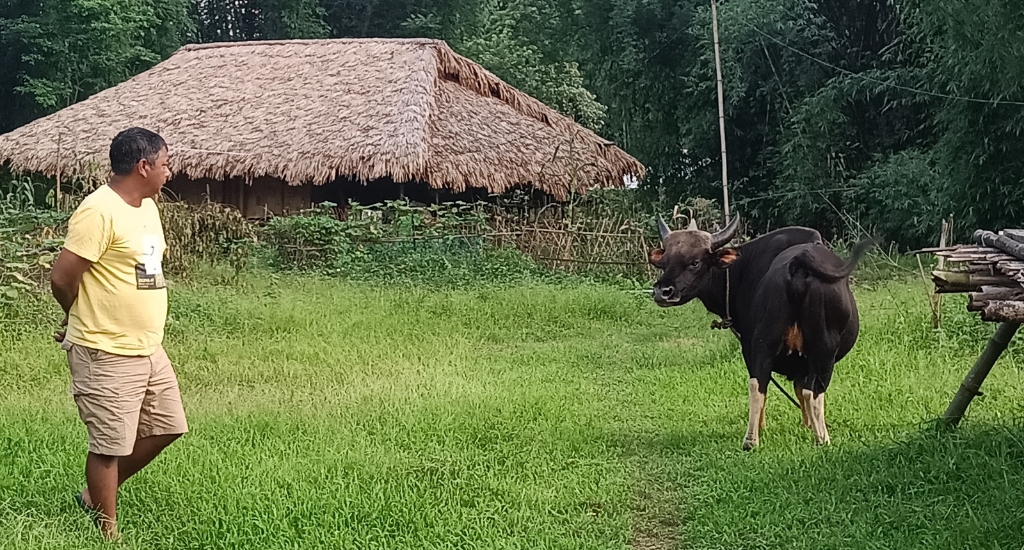The monsoon is being blamed for causing a bit of a ruckus in Mirem, a quiet village of the Adi tribe on the banks of the Remi river in East Siang district of Arunachal Pradesh. As clouds gather over the foothills of the eastern Himalayas and rain begins to fall, the community’s most precious possession mithuns become its most vulnerable.
Weighing in at 800 kg of pure muscle and sporting a pair of horns sometimes 6 feet across, an adult mithun — or gayal, a semi-domesticated animal similar to the Indian bison — packs a powerful punch. However, when it rains, this brawny beast can barely rely on its sense of smell and sight to detect lurking predators, particularly the dhole wild dogs.

Unlike other livestock, the tribespeople allow their mithuns to remain free-range animals, foraging in the forest. Owners identify their animals from cuts on their ears and use these to track their locations in the forest. Mithuns have a strong attraction to salt. The owners carry salt and lure their animals holding a handful of it. Drawn by the scent, the mithuns approach their owners, making it easier for them to be tethered whenever necessary.
The gathering clouds trigger a mad scramble among the villagers to corral their mithuns into sheds or fenced enclosures.
“Jungli kutta (dholes) come out in packs and prey on mithuns during this time,” Tapiyem Mize shouted as he hurried out with the others toward the forest across the river. He spent the entire day in the jungle, searching for his five mithuns and bringing them closer to home, where he could keep watch for any threats.
Risks and rituals related to mithuns
What compels an entire village to risk their lives in the depths of a tropical rainforest to save their livestock? What connection does Tapiyem, a father of four, have with his mithuns?
Also Read: This Arunachal boarding school is fostering Adi tribe’s cultural heritage
For the Adi tribe, the answer lies in a profound bond with their mithuns that goes beyond simple ownership. For generations, the mithun has been the lifeblood of the tribe, serving as a form of barter before money existed.
Even in a world that is changing rapidly, a family’s status in the community is often measured by the number of mithuns they own. These majestic creatures are also central to the tribe’s marriage customs, where traditionally, they were given as dowry to the bride’s family. Depending on the mithun’s size, health, and beauty, their value can range from Rs 50,000 to Rs 1 lakh.

For Tapiyem, a farmer whose wife earns Rs 2,000-Rs 3,000 a month by working in a self-help group making tea, the pressure to provide mithuns as dowry once loomed large.
“In some communities, they give off 20 to 100 mithuns as dowry. I can’t afford that,” Tapiyem said, explaining that the cost of transporting even one mithun could easily exceed Rs 70,000.
However, a recent shift in the Adi community’s social norms has eased this burden for families like his. The traditional council Adi Bane Kebang stepped in to address the growing economic disparity brought on by excessive dowry demands.
The kebang is an assembly of village elders, tasked with settling disputes and maintaining social order through compensation rather than confrontation. They follow orally passed-down traditions and customs. Their decisions have the power to transform the community. One such decision was a ban on dowry in 2022, which includes a hefty fine of Rs 25,000 for each mithun given as bridal price.
Ban on Mithuns in dowry: Curbing wealth displays
The move was designed to curb the ostentatious display of wealth that had crept into the tribe’s wedding ceremonies.
Also Read: The notice that proves no one takes dowry in this village

“In the old days, we didn’t have these displays of wealth at weddings. This is something that has come with modern times, especially among the affluent,” said 63-year-old Mirem resident Tanyup Taggu, who has been instrumental in enforcing the ban. “Now, we allow gifts of pigs or apong (rice wine), but not mithuns.”
The ban has had a meaningful impact. Since its implementation, there have been no reported cases of families defying the new rule. Even the wealthier families have complied, unwilling to pay the fines or face the potential social exile that comes with breaking kebang edicts.
“This was a step towards creating a more egalitarian society within the Adi community,” said Vijay Taram, the state information commissioner and general secretary of the kebang. “Mithun offering is still allowed during traditional festivals, but not for dowry.”
However, there are whispers of people continuing the practice discreetly.
“They send mithuns to the bride’s family before the wedding date,” said Tamuna Messar, a kebang member.
While such cases are rare, they are met with scrutiny by the kebang. If brought to the council’s attention, violators are fined and given a chance to plead their case before the jury of village elders and community members, who work together to uphold justice.
Also Read: Reverse dowry – empowering or subjugation?

Tapiyem, like many others in his village, is relieved by the changes.
“We’re poor people,” he said. “Where would we find the money to give mithuns? Now, society has banned it, and we can sleep easier at night.”
While the mithun remains central to their identity, its role in the community is evolving, allowing the Adis to honour their past while building a more equitable future for the next generation.
Also Read: Golden needles, purple tea: Women-led estate shines in Arunachal
The lead image on top shows Barun Taki with his mithun at his home at Mirem in East Siang district of Arunachal Pradesh. (Photo by Aatreyee Dhar)
Aatreyee Dhar is a Village Square Fellow 2023-24. She works as an independent journalist in Assam.








